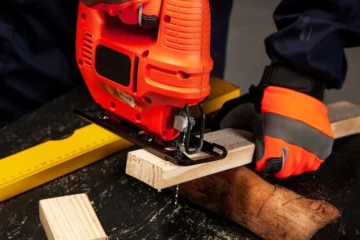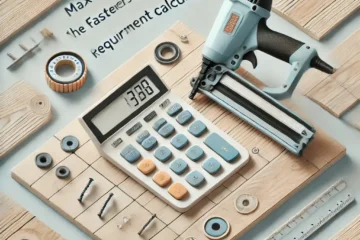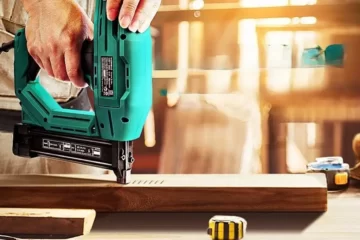In the world of construction and DIY, nail guns have revolutionized how we work, making tasks that once took hours now possible in minutes. Among the different types of nail guns, electric nail guns have grown in popularity due to their convenience and efficiency. But how exactly do electric nail guns work? What sets them apart from their pneumatic and gas-powered counterparts?
In this in-depth guide, we’ll explore how electric nail guns operate, the benefits of using them, and practical tips to get the best results from your electric nailer.
Why Understanding Electric Nail Guns is Important
Whether you’re a professional contractor or a DIY enthusiast, knowing how your tools work can make a big difference in your projects. Electric nail guns are ideal for quick home repairs, light carpentry work, and even professional framing jobs. Understanding how these tools function can help you make informed choices, ensure safety, and achieve the best results.
This guide will cover everything you need to know about electric nail guns, from their basic mechanism to tips on selecting the right model for your needs.
How Do Electric Nail Guns Work?
The Basics of Electric Nail Guns
At their core, electric nail guns work by using electricity to drive nails into wood, drywall, or other materials. Unlike pneumatic nail guns, which require an air compressor, electric nail guns draw power from either a corded electrical source or a rechargeable battery.
There are two types of electric nail guns:
- Corded Electric Nail Guns: These plug directly into a standard power outlet and are often used for continuous work.
- Cordless Electric Nail Guns: Powered by rechargeable batteries, these offer greater mobility and are perfect for work in areas without easy access to electricity.
The Mechanism: How Do They Drive Nails?
The inner workings of an electric nail gun are surprisingly straightforward. When you press the trigger, the electrical motor activates a firing mechanism, typically a solenoid or a flywheel system, depending on the model.
- Solenoid-Based Electric Nail Guns: In these models, a solenoid creates a magnetic field when electricity flows through it. This magnetic field pulls a piston forward, driving the nail into the surface.
- Flywheel-Based Electric Nail Guns: Flywheel models use an electric motor to spin a flywheel at high speed. When the trigger is pulled, the flywheel engages with the driver blade, pushing the nail into the material.
Both types of mechanisms allow for rapid firing and efficient use of power.
Safety Features
Modern electric nail guns come equipped with several safety features to prevent accidental firing. Common safety elements include:
- Trigger locks to prevent unintended activation.
- Contact trip mechanisms, require the gun’s nose to be pressed against the work surface before it will fire.
These features ensure that electric nail guns are both powerful and safe when used correctly.
Why Choose Electric Nail Guns Over Other Types?
Now that we understand how electric nail guns work, let’s look at why they’re a popular choice.
1. Convenience and Portability
Electric nail guns, especially cordless models, offer unparalleled convenience. Unlike pneumatic nailers that require a bulky compressor and hoses, electric nailers are portable and easy to use in various settings.
You can take them to any job site without worrying about electricity access (for cordless models) or cumbersome equipment.
2. Lower Maintenance
With no need for air compressors or gas cartridges, electric nail guns require less maintenance compared to pneumatic and gas-powered models.
This means fewer moving parts to service and fewer consumables to buy, saving you time and money in the long run.
3. User-Friendly for Beginners
Electric nail guns are often more beginner-friendly, especially cordless models. They offer ease of use, and you don’t need to worry about adjusting air pressure or refilling fuel canisters.
Just charge the battery (for cordless models) or plug in the tool (for corded models), and you’re ready to go.
Practical Tips for Using Electric Nail Guns
While electric nail guns are generally easy to use, following these practical tips will help ensure that you get the best results:
1. Choose the Right Nail Size
Electric nail guns can shoot nails of different lengths and gauges, so it’s important to select the right nail for the job.
For delicate projects like trim or molding, use smaller brad nails. For heavier-duty tasks like framing, go for thicker and longer nails.
2. Adjust Depth Settings
Most electric nail guns come with adjustable depth settings, allowing you to control how far the nail is driven into the material.
For softer woods, you may want to reduce the depth to avoid driving the nail too deep, while harder woods may require maximum depth.
3. Practice Safe Operation
Always wear safety goggles and ear protection when using an electric nail gun. Keep your fingers away from the firing area, and ensure that the gun is unplugged or turned off when not in use. Never point the nail gun at anyone, even when it’s off.
Personal Experience: Why I Switched to Electric Nail Guns
As someone who has worked with various types of nail guns over the years, I found the switch to electric nailers to be a game-changer for my projects. For one, the portability of cordless electric nail guns is unmatched. I no longer have to lug around a compressor or deal with tangled hoses on the job site.
In addition, the convenience of being able to charge a battery and get to work without any additional setup time has saved me countless hours. I’ve also noticed that the maintenance is much lower, allowing me to focus more on my work and less on keeping my tools in good shape.
I’ve used brands like DeWalt and Ryobi, and both have proven to be reliable over the years. While I still keep a pneumatic nail gun for heavy framing, electric nail guns are now my go-to for most other tasks.
Conclusion: Why You Should Consider an Electric Nail Gun
Electric nail guns are a great investment for DIYers and professionals alike. Their ease of use, portability, and low maintenance make them a smart choice for a wide range of tasks. Whether you’re building a deck, hanging trim, or doing light framing, an electric nail gun can make your work faster, easier, and more efficient.
If you’re in the market for a nail gun, I highly recommend considering electric models, especially if you value convenience and versatility. Try one out for yourself, and you’ll quickly see why they’re becoming the go-to tool for many people.
FAQs
Are electric nail guns as powerful as pneumatic nail guns?
While electric nail guns are highly effective for most tasks, pneumatic nail guns still offer more power, particularly for heavy-duty tasks like framing.
However, advancements in electric models have significantly closed this gap, and many cordless nailers can now handle tough jobs.
How long do cordless nail gun batteries last?
Battery life depends on the model and usage. On average, a fully charged battery can drive anywhere from 400 to 1,000 nails before needing to be recharged. Investing in a spare battery is a good idea for longer projects.
Can I use electric nail guns for outdoor projects?
Yes, electric nail guns can be used outdoors. Just make sure you’re using nails that are suitable for exterior use, such as galvanized nails that resist rust.
Cordless models are especially great for outdoor work where electricity may not be readily available.




